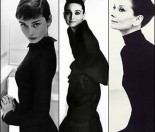Colour has a kind of magic about it.
Choosing particular colours can make your complexion glow with health and your eyes sparkle with vitality. Then there are the unseen but equally powerful abilities of colour to instantly lift your mood, increase your confidence and energy, and help others to understand and respond to you more positively.
Of course, part of ‘magic’ is the mystery, and the fact that it can go so horribly wrong.
After years in a school uniform and whatever-got-handed-down-to-me, I wanted to embark on my university life with a new wardrobe that made me look interesting, intelligent, and sophisticated. (Of course, by ‘new wardrobe’ I mean the Otago-Arts-Student definition which means to go to Red Cross op shop and fill-a-bag-for-$1.)
I thought I couldn’t go wrong with my new look of black jeans, black tops, and black jacket. Black, after all, is a universally flattering colour suitable for any occasion is it not? For a bit of colour, I accessorised with a bright orange scarf to go with my mums 1960’s orangey-brown nomads that I discovered fitted me.
However, instead of looking mature and sophisticated, I soon realised that looked as though I was permanently suffering from Fresher Flu: pale and potentially contagious. I ended up tying the scarf around my head as a turban to act like a kind of rescue beacon so my friends could find me in the crowded cafeteria.
Thankfully, my second year brightened up considerably when I gained the confidence to actually be myself, rather than pretend to be something else. I embraced my creative, passionate and inquisitive personal characteristics and the cool, clear colours of my eyes, skin and hair colour. I re-donated my bag of black to the Red Cross in exchange for plum-reds, deep purples, and teal-greens. Oddly, that was the year I also started noticing and appreciating other people’s character and styles much more, now that I was no longer worried about how I looked and what impression I was making.
It was some years later when I studied personal colour consulting that I understood the art and the science behind these instinctive choices; the match between personality, colouring and clothing.
Give or take a decade or so of working in fashion, design and styling, I have met plenty of other men and women who have, just like me, picked up on a rule about colour and feel like something has been lost in translation, or that they’ve missed the footnotes that explain all the terms and conditions.
Examples of the old rules:
• “Olive skinned people shouldn’t wear green because it brings out the green in their skin.”
• “Fair people cannot wear light colours because they’ll look washed out.”
• “Brunettes suit pink; blondes suit blue.”
• “Girls with red hair cannot wear pink… or red… or green.”
• “No one looks good in yellow.”
• “Everyone looks good in black.”
• “Navy is the new ‘black’.”
• “Grey is the new ‘black’.”
• “Black is the new ‘black’”…
Really, there’s little wonder we long for something other than black, but always come home from a shopping trip discouraged, carrying a new black cardigan.
General, ‘must follow’ fashion rules like these just don’t allow for exceptional individuals.
Thankfully, like most magic, as soon as you hear how it is done, you can astound your family with your new super-powers of always looking stunning, the ability to co-ordinate outfits at the speed of a bullet, and having the energy and confidence to fly through your to-do list.
Here is my beginners’ guide for performing colour magic:
Step 1: Have a think about how you want to feel, and how you want other people to see you.
Colours carry a huge amount of information that we can use to convince those around us that we really mean what we say, whether we want our instructions followed to the letter, or we need a hug. (This is a huge topic in and of itself, but once we start to think about it, common sense is a pretty good guide.)
Step 2: Take a look in the mirror and find your shade of that particular colour.
The secret to choosing colours that flatter, is finding the shades of that colour that already belongs to you.
Go further than seeing your eyes as ‘grey’ or ‘blue’ or ‘brown’, your skin as ‘beige’, and your hair as ‘brown’ or ‘blond’ or ‘red’. Actually notice the shades and variations in your eyes, skin, and hair.
If you want to wear black, look for the darkest colour you can find in your eyes. If you want to wear red, look for the reds you can see in your lips, or when you blush. If you want to wear blue, look for blues in your eyes or in the colour of your veins.
Step 3: Enjoy variety.
Tomatoes are a super food, but if you ate nothing but tomatoes you’d get sick. The same is true of colour. No doubt you remember how long it took in your adult life to feel comfortable wearing pink, after overdosing on it in childhood. Or how you still cannot bring yourself to wear the colour of your school jersey.
Look for other examples in nature that include your colours. For example, in a field of spring flowers, or beside a river in mid-summer, or maybe the autumn leaves, or the clear night’s sky of mid winter? (This is the reason the four seasons have been used for so long to help people understand their personal colour harmonies.)
Be creative and experiment with wearing different colours together. As all your colours work together in your ‘natural landscape’, they will all work together in your wardrobe too.
So that is the secret behind the magic of choosing colours that suit you. It all starts by understanding what colours already belong to you, and therefore, which colours belong in your wardrobe.
This is the first of a 6 part series Fiona is writing for us on developing style confidence. The next article will feature tips on dressing to suit your body shape.











Great article. Thanks Fiona. 🙂